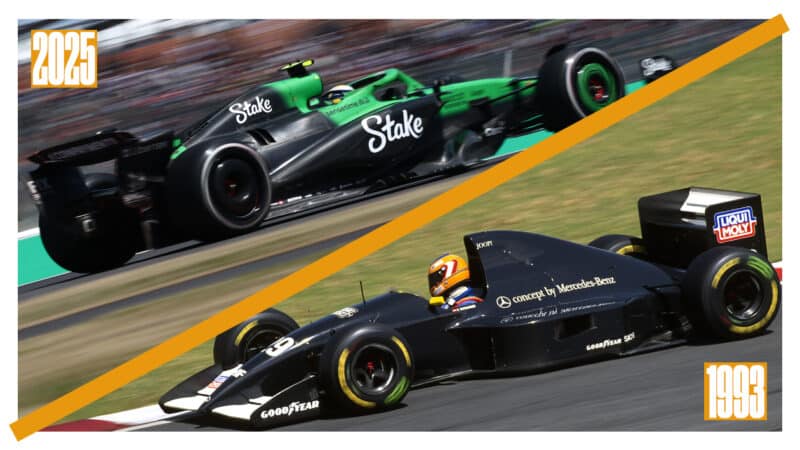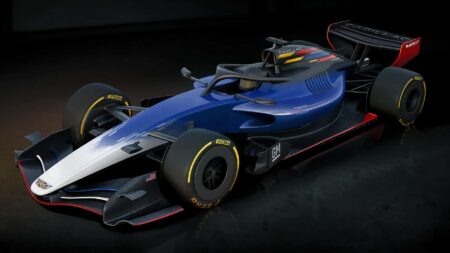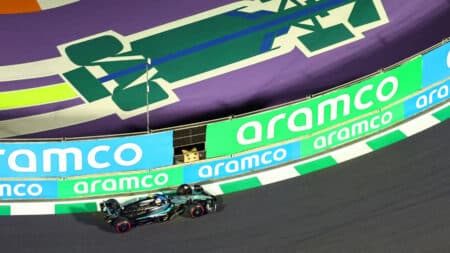
Norris must deal with Piastri's pace – or suffer Mark Webber's fate
As Oscar Piastri moved into the championship lead, his manager Mark Webber's example should serve as a warning to Lando Norris, says Mark Hughes

Grand Prix Photo / Sauber
This weekend’s Japanese Grand Prix introduces the first one-off car liveries of the 2025 season, with two teams unveiling designs that take inspiration from the country they are racing in.
Haas‘s car is sprinkled with pink cherry blossom, while Red Bull has turned white, in tribute to engine supplier Honda, with a series of clever design details that reference the Japanese firm’s first F1 winner.
But that’s not to say that the standard colour schemes used for the majority of the season are any less inspired. In fact, there’s a lot more to several liveries than you may have appreciated.
Here, we explore the background to each F1 team’s 2025 livery.
The 2025 season will be the very last in Formula 1 for the Sauber team, which has been bought by Audi and will be rebranded as the car manufacturer’s factory team next year.
Its final livery, shown at the top of the page, acts as a throwback to the distinctive paint scheme used by Sauber in its maiden 1993 F1 season — an all-black affair for the virtually sponsor-less team.
The front of the 2025 car is caked in the garish green of gambling firm Stake, but this fades just past the cockpit, leaving a plain black engine cover.
While the effect may be inadvertent — Sauber didn’t mention it at the car’s launch — it’s reminiscent for anybody who remembers the team’s debut year, 32 years ago, when Karl Wendlinger and JJ Lehto drove the privately-owned team to a creditable seventh place in the constructors’ championship with 12 points, in a period where only the top six finishers were awarded points.
Williams‘ single goal is to return to the glory years that brought it nine constructors’ and seven drivers’ championships. The current livery literally puts that front and centre.
While the team’s branding is overwhelmingly light blue, the nose of the car is — and has been for some years — a darker shade, which replicates the colour used on the most successful cars in the team’s history.
They include Nelson Piquet’s 1987 title-winning FW11B, as well as the run of 1990s cars that Nigel Mansell, Alain Prost, Damon Hill and Jacques Villeneuve drove to championship success. After the latter’s title in 1997, the nose turned red, along with the rest of the car, to placate new sponsor Winfield. And the winning came to an end.
Lewis Hamilton might have left, but the black livery section on year’s Mercedes represents a bold commitment that his legacy at the team will continue.
It began 2020, during the period of Black Lives Matter protests. Encouraged by Hamilton, Mercedes made the “big step” of jettisoning its Silver Arrows livery and taking a stand against racism and discrimination with a black paint scheme.
More than just a statement, it led to the creation of Ignite, a charitable partnership between Hamilton and Mercedes to change the white, male-dominated face of F1, providing new opportunities and role models. The team also pledged to hire at least 25% of recruits from under-represented groups.
Team boss Toto Wolff indicated that this work would continue when he assured Hamilton that the car would continue to feature a black livery: “It’s what you brought,” he told the seven-time champion in a video released at the beginning of the year.
The black is blended with the silver that links the current team to its successes in the early years of grand prix racing, when the likes Rudolf Caracciola and Bernd Rosemeyer won for the Silver Arrows.
Don’t forget either the red star that every Mercedes F1 car has carried since the 2019 Monaco Grand Prix: the first race since the death of Niki Lauda — one of the architects of the team’s staggeringly successful return to grand prix racing.
As you’d expect on a car that acts as a mobile billboard for the energy drink company that owns the team, Red Bull’s branding dictates the livery and remains fairly constant from season to season.
There’s little new to analyse there, so let’s be grateful for the one-off Japanese Grand Prix paint scheme that gives us much more to go on.
This is the last home race for Honda as Red Bull’s engine supplier, before it switches to powering Aston Martin in 2026. In celebration of the four drivers’ and two constructors’ world championships won by the partnership, this weekend’s car will be a tribute to the Japanese firm.
It’s the second time that Red Bull has come up with a white livery to bid farewell to Honda at the Japanese Grand Prix: it did so in 2021, after Honda announced it was pulling out of F1. The car actually ran at the Turkish Grand Prix, after the East Asian rounds were cancelled due to Covid. Then Honda continued supplying engines to the team for subsequent seasons.
The 2025 version is similar to the one from four years ago, with the white background reminiscent of the Honda’s first F1 winner: the RA272 that Richie Ginther drove to victory in the 1965 Mexican Grand Prix.
The Honda branding on the engine cover uses the same font as Ginther’s car, and the H on the nose is a replica of the 1965 badge too.
The car number sits on a red disc, mirroring the centre of the Japanese flag, as well as Ginther’s Honda.
F1 brownie points go to Ferrari for wholeheartedly joining efforts to mark the 75th anniversary of the World Championship this year.
The commemorative livery isn’t a great surprise given the team is the only one to have competed during every season, and is understandably proud of its heritage.
This year’s car uses a darker shade of red than the ‘Rosso Scuderia’ shade used in previous years, and reflects the burgundy colour that the first Ferrari cars used from the maiden 1950 season.
One advantage of Ferrari’s long history in F1 is the range of past details that can be repurposed, such as the white strip on the engine cover, which fits the corporate branding of new sponsor HP, while also being reminiscent of the legendary 312T of the mid-1970s. Gilles Villeneuve, Niki Lauda and Clay Regazzoni all won races in the cars, which ran with a white airbox.
For some, McLaren will always be associated with the white and red Marlboro livery of the Senna and Prost years. For others it’s the dazzling silver during the seasons when Mika Hakkinen and Lewis Hamilton won titles with Mercedes-powered cars.
But in 2017, the team reached much further back to its very origins when it re-adopted the papaya livery that first appeared in F1 on its 1968 F1 cars, as raced by founder Bruce McLaren.
Yardley sponsorship in 1972 saw the colour scheme dictated by sponsors until 45 years later, since when backers have had to work around the orange theme.
This year’s livery is even more consistent than usual — the black and orange pattern is virtually identical to last year’s car. Team principal Andrea Stella said that the team had chosen to maintain the design in “honour” of the 2024 car that delivered the team’s first constructors’ championship since 1998.
Metallic blue has become indelibly associated with Alpine thanks to the sporting success of its A110, which filled the top three places in the 1971 and 1973 Monte Carlo rallies, the winner on both occasions running in the crisp sky-blue livery.
It’s a heritage that the brand clings to, even if the F1 car is diluted by the pink of sponsor BWT.
Attempting to pinpoint the precise shade of British Racing Green could spark a debate that lasts weeks. But most would agree that the colour of Aston Martin’s F1 car is not it.
In fact, the company calls the metallic shade ‘Aston Martin Racing Green’ and it’s said to be the most popular paint choice for buyers of its road cars.
The current shade was developed for the brand’s return to F1 in 2021 and takes inspiration from the ‘Almond Green’ used on the DBR4 during Aston’s first, brief Formula 1 foray in 1959.
The company says that it is the product of 100 different options, which were assessed with light guns at different lighting levels to ensure that the car looks vibrant at racing circuits around the world.
Since its 2016 F1 debut, this livery has been fairly consistent, following the design theme of Haas Automation, which produces the profits that has allowed Gene Haas (inset) to bankroll his team.
There’s currently little pressure to remove the trademark red highlights given that the colour features heavily in the logos of major sponsor Moneygram and partner Toyota Gazoo Racing.
There’s disappointingly little to say about the story behind the most popular livery on the grid in 2025.
The team simply said that the shift to a white colour scheme was “a nod to the overall brand of Red Bull”. Also in mind may have been the overwhelmingly positive response to Red Bull’s white Honda tribute livery from 2021, as mentioned above.
With no heritage constraints, the team has managed to create a design that few can fault.

As Oscar Piastri moved into the championship lead, his manager Mark Webber's example should serve as a warning to Lando Norris, says Mark Hughes

General Motors has pushed back its F1 entry as an engine supplier to 2029, but what does it mean?

As Mercedes dropped down the F1 order in Saudi Arabia, team boss Toto Wolff found a hope in Kimi Antonelli's performance for the team

Zak Brown is still adamant on his approach that Lando Norris and Oscar Piastri are ‘number ones’ at McLaren. But how long will it be before history repeats itself and takes a sour turn?